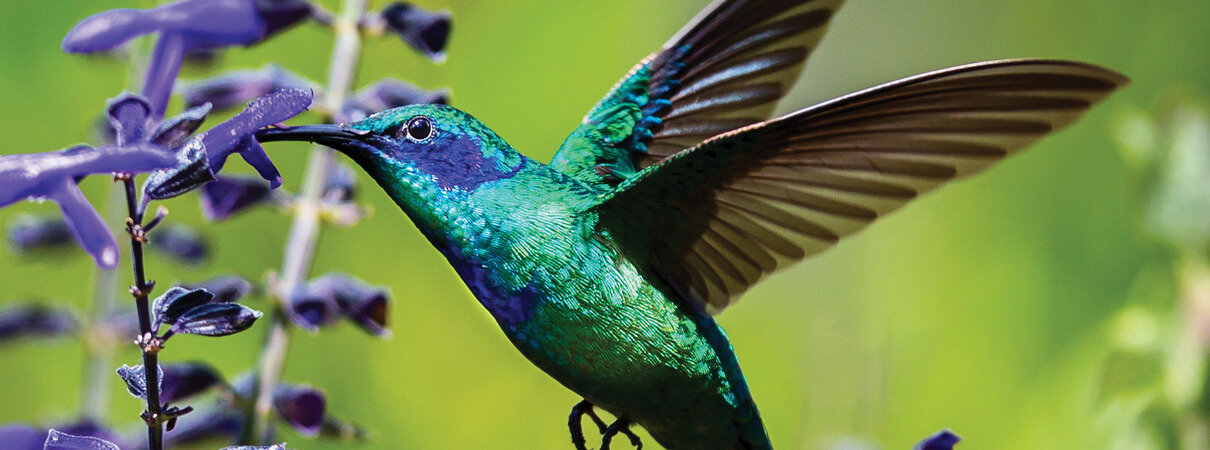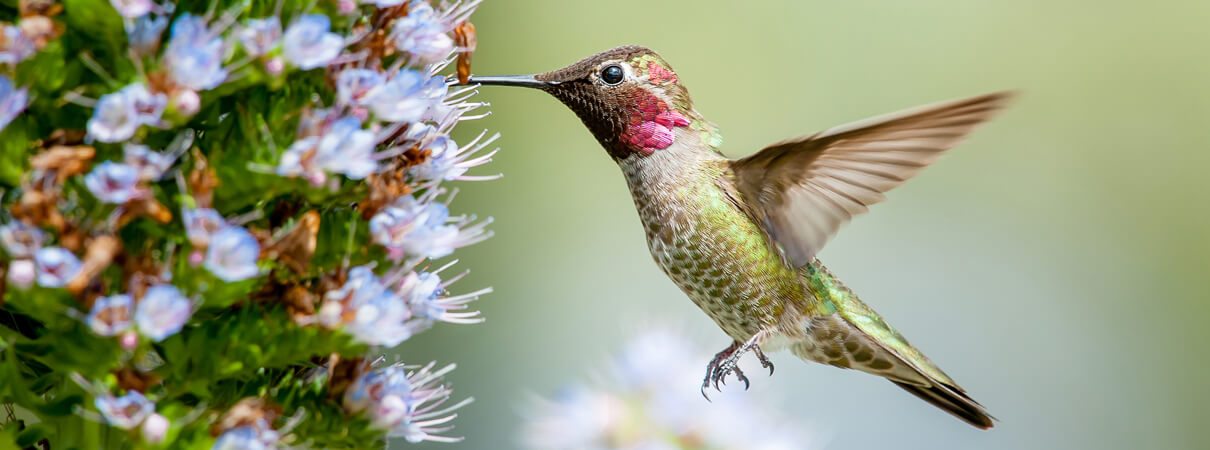High-Stakes Existence for Hummingbirds, Sparkling Jewels of the Americas
Imagine a Rufous Hummingbird traveling more than 3,000 miles on his annual spring migration from Mexico to British Columbia. Armed with a prodigious mental map of every place he's ever found food, the tiny bird heads to a familiar spot in California where he remembers a field full of flowers. He arrives only to find a big-box store and a giant parking lot. No flowers, no nectar. But the hummingbird has no time to waste; he spends the majority of his waking life gathering food to survive. So he flies on.
Ross Hawkins tells this story to illustrate the impressive—but occasionally harrowing—intensity of a hummingbird's existence. If they don't consume enough calories in a day from nectar and small insects, they can suffer, says Hawkins, who is the founder and executive director of The Hummingbird Society. It's a high-stakes hunt for food that most humans never experience. “My wife says, ‘Did you forget to get what I sent you to the grocery store for?'” Hawkins says. “A hummingbird can't do that.”

Velvet-purple Coronet, Martin Mecnarowski/Shutterstock
The Americas are home to 365 species of hummingbirds. Of these, the International Union for Conservation of Nature lists 28 species, or roughly 8 percent, as endangered or critically endangered. For most of these declining hummingbirds, loss of habitat is the leading threat to their survival. None of the species that occur in the United States and Canada are threatened with extinction. But all of the hummingbirds that are currently endangered have very small ranges in Mexico and Central and South America.
Among them are the Short-crested Coquette, a wild-haired hummer that lives only along one road in the Sierra Madre del Sur in Mexico; the Glittering Starfrontlet, dark with a metallic sheen, and found only in two tiny forest fragments in northwest Colombia; and the Chilean Woodstar, a tiny, iridescent hummer that is perhaps Chile's most threatened bird.
The critically endangered Black-breasted Puffleg is another. Fewer than 300 individuals survive in the hummingbird's home on the slopes of Volcán Pichincha in Ecuador. In 2001, our Ecuadorian partner Fundación Jocotoco started what is now a 2,900-acre reserve of high-altitude forest to protect the puffleg, which migrates up and down the slopes of the volcano according to the season.

Black-breasted Puffleg, Murray Cooper
“It's easy to rally support for creatures that bring so much beauty and joy into our lives, but hummingbirds are far more than just pretty faces,” says Sheri Williamson, the author of A Field Guide to Hummingbirds of North America (Peterson Field Guide Series). Many hummingbird-pollinated wildflowers, for instance, are pioneer species that colonize disturbed areas after fires and landslides, helping to protect and stabilize fragile soils while a new generation of shrubs and trees gains a foothold. “Hummingbirds have positive impacts far out of proportion to their size,” she says.
Mechanical Wonders
Hummingbird names are perhaps the first hint of something special. Colorful, outlandish words christen the tiny birds, as though whoever named them wanted descriptions as eye-popping as their subjects. There are sicklebills and pufflegs, woodnymphs and fairies, sunbeams and sunangels, and enough rubies, sapphires, and emeralds to make a jeweler jealous.

Little Woodstar, Peter Hawrylyshyn
Many are minuscule: Cuba's Bee Hummingbird, which weighs about the same as a large paper clip, is the world's smallest bird. Then there are the incredible mechanics of their small bodies. Hummingbirds fly forward, backward, up, down, and sideways—dexterous flight patterns unlike those of any other bird. This nimble flight and ability to hover in place has even attracted the attention of the Defense Advanced Research Projects Agency, also known as DARPA, which has funded the development of remote-controlled aircraft, or drones, modeled after hummingbirds.
Downy they are not. Yet some hummingbirds have nearly as many feathers as birds several times their size. Most hummingbirds, especially coquettes, flash about with outrageous ornamentation or glittering colors that appear to change from different angles of view.
Yet the lack of down is one reason hummingbirds, whose internal temperature is around 104 or 105 degrees Farenheit, must work hard to stay warm. So it's no surprise that the greatest diversity of species occur in the tropics. Even there, some hummingbirds live above the snow line of the Andes. (An ABC scientist once saw an Andean Hillstar above 17,000 feet in Bolivia.) Hummingbirds cope with cold temperatures at night by slipping into torpor to lower their body temperature along with their heart and breathing rates, helping to conserve energy.

Green Violetear, Glass and Nature/Shutterstock
Amazing Migrations of Hummingbirds
However limited some hummingbirds' ranges are, many do migrate. Most stay in one place or travel short distances, perhaps moving up and down in elevation as flowering plants bloom. Most hummingbird species that occur in the United States travel farther; those that don't are found in resident populations in the warm Southwest.
Their superb spatial memory powers them along, whether they're traveling a few miles or a few thousand. Other birds are known for this too, but hummingbirds do it especially well. They follow a route and forage systematically, sometimes returning season after season to very specific, individual plants.

Anna's Hummingbird, Johanna van de Woestijne
“Migrating hummingbirds do some things that remind me of migrating shorebirds,” says George Wallace, ABC's Vice President of Oceans and Islands. In August, alpine meadows in the Rockies will be swarming with hundreds of hummingbirds, he says, all going after the nectar. “These stopover sites are probably very important—the same way a site such as Delaware Bay is important to migratory shorebirds.”
Only recently have scientists begun to trace with precision their impressive migratory paths. A new study of Ruby-throated Hummingbirds, published this year in The Auk: Ornithological Advances, has shown that the birds are capable of traveling an average of 1,400 miles between refueling stops as they migrate between eastern North America and Central America.

Ruby-throated Hummingbird, Kelly Nelson/Shutterstock
Researchers captured 2,200 or so Ruby-throated Hummingbirds at Bon Secour Wildlife Refuge near Mobile, Ala., which were heading south toward their wintering grounds. By analyzing the birds' fat reserves over the course of five consecutive autumns, the researchers determined the tiny birds were capable of traveling roughly 1,200 miles in a single flight.
It's an impressive distance for a bird about the weight of a dime—but perhaps not altogether surprising. We've long marveled at hummingbirds' grit. This is just one more bit of proof.
Editor's note: This article first appeared in the summer 2016 edition of Bird Conservation magazine.
 Libby Sander is Senior Writer and Editor at American Bird Conservancy. She spent 13 years as a journalist before coming to ABC, writing news stories and award-winning features for The New York Times, the Washington Post, and The Chronicle of Higher Education. You can follow her on Twitter at @libsander.
Libby Sander is Senior Writer and Editor at American Bird Conservancy. She spent 13 years as a journalist before coming to ABC, writing news stories and award-winning features for The New York Times, the Washington Post, and The Chronicle of Higher Education. You can follow her on Twitter at @libsander.


















































